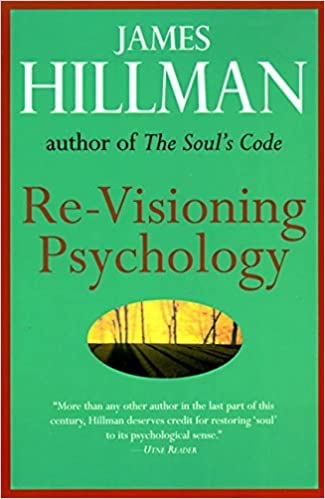James Hillman (1975) Re-Visioning Psychology. Harper
0. To begin with…
Fantasy-images are both the raw materials and finished products of psyche, and they are the privileged mode of access to knowledge of soul. Nothing is more primary. (xvii) #glossary
Let us then imagine archetypes as the deepest patterns of psychic functioning, the roots of the soul governing the perspectives we have of ourselves and the world. (xix) #glossary
1. Personifying or imagining things
Our semantic anxiety has made us forget that words, too, burn and become flesh as we speak. (9)
Loving is a way of knowing, and for loving to know, it must personify. Personifying is thus a way of knowing, especially knowing what is invisible, hidden in the heart. (15)
Memory not only records, it also confabulates, that is, it makes up imaginary happenings, wholly psychic events. Memory is a form imagination can borrow in order to make its personified images feel utterly real. (18)
I dream and experience my dreams as inside me and yet at the same time I walk around in my dreams and am inside them. (23)
We conceive our psychological nature to be naturally divided into portions and phases, a composition of earlier and later historical levels, various zones and developmental strata, many complexes and archetypal persons. (24)
Through this multiple schizoid perspective we saw a world no longer held together by reason, no longer held and centered at all. Instead: disordering spontaneity, relativity, discontinuities, a-harmonies, an overpopulation of spirits and living soul images–the return of archetypal persons. (25)
Polytheistic psychology refers to the inherent dissociability of the psyche and the location of consciousness in multiple figures and centers. (26) #glossary
If I let myself be defined as well by the little people of dreams, I am free of self-tyranny. (33)
In dreams the fragmentation into parts is held together by scenes and woven into stories. (33)
We can describe the psyche as a polycentric realm of nonverbal, nonspatial images. (33) #glossary
Clinically, this polycentricity would be condemned as schizoid fragmentation, demonstrating the ambivalence of a center that cannot hold. But mythically we might look for a God in the disease, perhaps Hermes-Mercury or the Trickster. For schizoid polycentricity is a style of consciousness and not only a disease; and this style thrives in plural meanings, in cryptic double-talk, in escaping definitions, in not taking heroic committed stances, in ambisexuality, in psychically detached and separated body parts. (35)
Though art may hide a multitude of psychological ignorances, at least it does not ask images what they mean. (39)
Since it starts anywhere, it can break off anywhere. Fantasy does not need to achieve a goal. (40)
But ego dissolution does not mean disorder, since all fantasy is carried by a deeper, archetypal order. (40)
The best test of authenticity concerning our disciplines of exploring the imaginal is that the habitual ego senses itself at a loss and is unable to identify with the images. They must be alien even while familiar, strangers even if lovers, uncanny although we rely on them. (41)
The more profoundly archetypal my experiences of soul, the more I recognize how they are beyond me, presented to me, a present, a gift, even while they feel my most personal possession. (49)
2. Pathologizing or falling apart
The psyche uses complaints to speak in a magnified and misshapen language about its depths. (82)
Dreams tell the soul’s tales in persons and they also use the language of animals and landscapes, much as the Gods told of their different archetypal qualities through persons, animals, and landscapes. The soul may speak of itself as a desert, an isalnd, an airport. It may be a cow or a tiger. Dreams also use parts of the body as parts of dream speech in which feet and teeth and heart do not refer to actual body parts. And dreams use the family as a mode of symbolic speech–where “brother” and “father” and “son” convey emotional messages beyond the factual family members. (82)
Sick figures–crippled, with venereal disease, hurtling toward an accident, locked in a closed ward–have an exceptionally moving power. We start up, afflicted, haunted through the day, psychologically on edge. The pathologized images have moved the soul in several ways: we are afraid; we feel vulnerable and in danger; our very physical substance and sanity appear to be menaced; we want to prevent or rectify. Especially this last seizes us. We feel protective, impelled to correct, straighten, repair. For we have confused something sick with something wrong. (83)
Guilt belongs to the experiences of deviation, to the sense of being off, failing, “missing the mark”… However the true missing of the mark is taking the guilt literally, where failings become faults to be set right. This places the guilt on the shoulders of the ego who “should not” have failed. Then pathologizing reinforces the ego’s style and guilt serves a secondary gain, increasing the ego’s sense of importance: ego becomes superego, driven busy with repairing wrongs. A guilty ego is no less egocentric than a proud one. (83)
The affliction reflects a pathos, a being moved, or movement, now taking place in the psyche. (84)
If there is anything wrong or dangerous in regard to pathologized fantasies it is in how we treat them; our attitude may turn them into the very events we fear. Our attitude toward the pathologizing may be more destructive than the pathologizing itself. (87)
Therefore an individual cannot provide a norm even for himself. The many persons which play their parts through an individual have differing paths to follow, different moments of rise and decay, different Gods to obey. (88)
If the fundamental principle of psychological life is differentiation, then no single perspective can embrace psychological life, and norms are the delusions that parts prescribe to one another. (88)
Pathologizing moves the myth of the individual onward by moving him first of all out of the heroic ego. (89)
The materials, vessels, and operations of the alchemical laboratory are personified metaphors of psychological complexes, attitudes, and processes. Every one of the alchemist’s operations upon things like salt, sulphur, and lead were also upon his own bitterness, his sulphuric combustion, his depressive slowness. (90)
Habits and attitudes that obscure psychic insight and have lost psychic significance need to be dissolved, or made to stink, becoming monstrous and repulsive, or grindingly rubbed away.
These operations were part of what was called in alchemy the opus: the work that today in psychology is referred to as “working through resistances.” (91)
Then, by transposing the art of memory into a lesson for soul-making, we learn that if the soul is to be truly moved, a tortured psychology is necessary. (92)
Both alchemy and the art of memory work within minimal space. The alchemical process is imagined to happen within a closed vessel. (93)
We learn that one need not soar and plunge on grand shamanistic journeys in order to affect the soul to its depths. These would be trips of the spirit which distend the soul, filling it with air or gas, inflation… Instead, the pathologized image held solemnly is what moves the soul. One dwells upon the affliction or dwells with it, in bed with the leper, in its embrace. And as in alchemy or in memorizing, one goes over and over the same ground again. This iteratio, as it was called, is the itinerary, fantasy ever returning to the same complex, moving it now this way, now that. A virtue of pathologizing is that it does not let us escape the closed space required for soul-making, the heat and oppression and intensity–all of which are the antidote for spiritual inflations. (93)
Then we have myriads of images, the soul a supermarket with a little of everything or a vast continent that urges us to superficial interior flights, tourists in the soul. (94)
..the deepening of psychological space increases through slowness. The alchemists spoke of patience as a first quality of soul and considered soul-making the longest journey, a via longissima. (94)
When an alchemical process or a tortured image is the relevant background to our psychopathology, then we see our distortion in the mirror of these distortions. Therefore, too, the best way to approach these fields is through our individual distress. (95)

